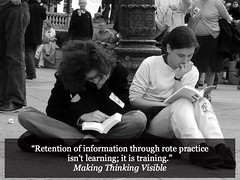Do you need to lecture in a lecture?
Theme 2 of the TESS programme was focused on teaching. The idea was to answer 3 “wh” questions:
Who are we teaching?
What do we want learners to learn/achieve?
How do we want learners to learn/engage?
These 3 questions link back to the way people learn. And they are also related to our one teaching and learning philosophy. In this sense, the act of teaching is connected to our professional values and the principles we share regarding our teaching vocation. Hence, I think it’s important that we ask ourselves what our role as educators is. Do we want to impart (static) knowledge [that’s an easy way to teach] or do we want learners to engage in a culture of knowing in which their activity/role is placed at the centre? This requires learners’ participation. Research does say that learners learn better when they are actively involved. This is due to the fact that participation is an act of belonging. We learn better when we are able to connect, physically and emotionally, to what we are learning. And isn’t learning a process of making connections between old and new information?
From Sage on the Stage to Guide on the Side
This leaves the educator with the responsibility of “animating” the classroom as part of the learning process, making it an engaging experience in which learners feel compelled to take part in. And this is probably our biggest challenge as educators, because it does require that we put that control back into the learning activity.
As part of that we looked at constructive alignment and the need to prepare our teaching sessions in such away that they promote effective learning.
In so doing, we need to be able to answer the 3 questions mentioned above. And those answers can be formalised by the development of clear and achievable intended learning outcomes (ILO) which aim to inform the structure of any given session we prepare as part of our teaching activity.
The learning outcomes – the what? – will then inform the how? in that we need to choose learning activities that may lead to the achievement of ILOs as well as the assessment (which we will explore in Theme 4)
We also looked how to write learning outcomes – these should make use of action verbs that lead the learner to demonstrate what they have learnt and achieved. We explored different types of verbs that help express different stages of the learning process, from the most simple stages such as identifying or following a simple procedure to the creation of something that reflects learning in a particular area. (a list of ILO verbs was provided for this activity)
The session ended with us sharing ideas about how we can teach small and large groups. Our discussions also aimed to demystify the assumptions that we cannot do active learning in a lecture slot, or for that matter, with large groups.
We should approach a lecture just like any other teaching opportunity. It aims to enable learners to learn and be involved in that learning experience. Hence, we should not focus on the meaning the word has acquired throughout the years given the experiences we have had as students ourselves. We should always personalise teaching to match our own convictions (philosophy). It should also take into account our understanding of how people learn and what the purpose of teaching really is! I believe teaching is a form of helping learners grow intellectually, of maturing their ideas… In facilitating that process educators’ grow too. Learning and teaching are not isolated activities. We are all learners and teachers. Understanding this dialectics enables us to understand our role better!
– How are you planning to put these ideas in practice?
– How hard is it to yield the control of the learning experience to the learner?
Resources:
Learning and teaching in laboratories
Short Guide: Postgraduate Demonstrators and Teachers *
* A big thanks to Dr Gemma Lace for letting me attend one of her lab session and share some literature with me.

